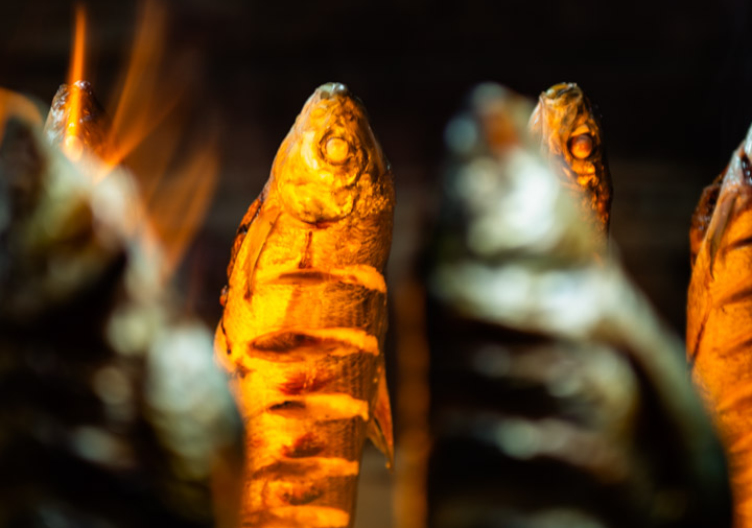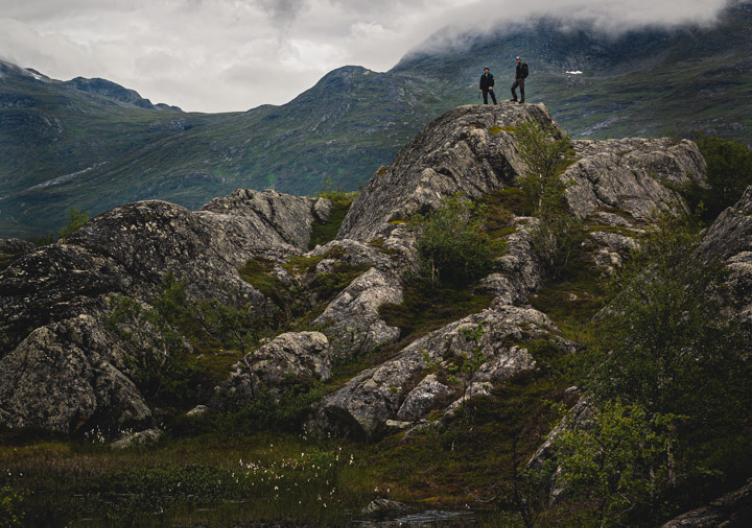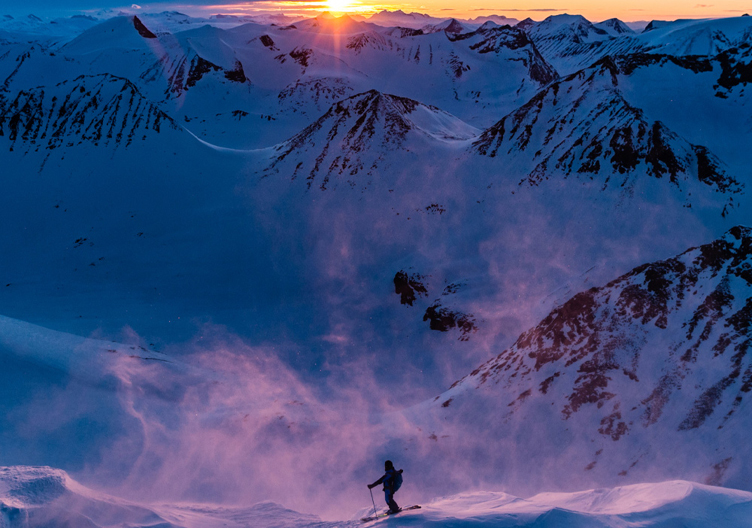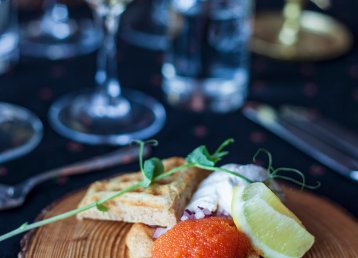She stands in the middle of a field of stinging nettles, smiling. Gloves, thick trousers and rubber boots all help, of course. Eva Gunnare, one of Swedish Lapland’s most exciting food ambassadors, is happy about the summer that seems to be approaching. And happy that the basket with nettle shoots is getting fuller. Soon we will have soup.
— I’ve been craving for this for so long, and the early-season vegetables have taken their time this year. I think it’s been seven months since I last picked something green.
About a week ago, Eva collected a few hundred litres of birch sap. Since then, she has also collected a lot of bark and left it to dry, and now she is hunting for nettles and spruce shoots. Eva Gunnare is a forager in every sense of the word and a northern food ambassador who left the usual stereotypes behind long ago. It is easy to think of ptarmigan, Arctic char and reindeer when the food of Swedish Lapland comes up in conversation or on the table. But the truth is that there is an exciting legacy beyond the obvious, even beyond smoked, cured and pickled. Because of course, the Sámi and settlers could not survive on hunting and fishing alone. They had to find vitamins and nutrients elsewhere as well. They learned to live off what the land provided, from bark to berries.
Something njálgge
A few weeks later, at home in Eva Gunnare’s kitchen in Jokkmokk, an unforgettable meal is served. A dinner that is also a food journey through the eight seasons of the Sámi told with all the love Eva and her partner Helena Länta have for Sápmi.
— It’s been exciting for me too, coming along on this food journey that Eva and I started with Njálgge, reindeer herder and entrepreneur, Helena explains.
— So many new flavours and so much new knowledge have emerged.
Together Eva and Helena offer one of Swedish Lapland’s most exciting and definitely most educational dining experiences with their concept Njálgge.
The word njálgge is Lule Sámi and means something is tasty, even a bit more than tasty: really, really good. When Eva and Helena started talking about creating a dining experience for visitors, they wondered what to call it. But one day they said: We just want to offer something tasty, something njálgge. So that became the name for the whole experience.
Eva Gunnare
Eva Gunnare’s story is not typically Sámi; she is from Stockholm and worked for the Swedish Tourist Association in Kvikkjokk, where she met her husband, a reindeer herder and craftsman. Today their children work as reindeer herders, among other things, and Eva has a lot of insight into everyday Sámi life because of this. Eva was always interested in food, and one day she decided that she would go to school and be taught by Sámi food creator Greta Huuva in Jokkmokk. There she was enthralled by all the flavours and possibilities.
— Before I took that course with Greta, I guess I was pretty stuck in my opinions about Sámi cuisine. Based on game and reindeer and fish, most of it salted, dried and smoked – unless it was eaten fresh, of course.
— But the first time Greta showed me how to use bark in bread, spruce shoots in marinades and sorrel in sauces and dressings, it was like opening a whole new door – a door that led to something absolutely fantastic.
That door has never closed, either, as a curious mind opened it. It was also a good thing because a lot of what lay behind that door was about to be forgotten.
Helena Länta
Helena has had a more traditional Sámi upbringing. Her family has always been reindeer herders, and her summer months were spent at Árasluokta, in Bádjelánnda national park, where her reindeer-herding community Jåhkågaska has its summer residence. Helena definitely had cloudberries, lingonberries and blueberries, perhaps a couple of mushrooms. But she would never have made syrup from dandelions or ’asparagus’ using shoots from willowherb. She had never even heard about it before she started working with Eva.
There was another dinner – the first time I had the good fortune to try Njálgge – when Helena had slaughtered a reindeer the same day as dinner was served. You rarely get a chance to eat absolutely fresh meat that has never been in the freezer or hung in a tenderiser cabinet. But reindeer meat does not have to hang before it’s eaten. The reindeer is already tender, and that is why one of the significant yearly events for every reindeer owner is the slaughter when they get to make a proper ’reindeer stew’. Water, salt and fresh reindeer meat in a pot boiling over a fire. As simple as it gets.
– It is essential to get some fat and marrow in there; the broth tastes better that way. I usually put a piece of the backbone in, breaking it apart a little. That makes a good broth, Helena explains.

Reindeer
Reindeer are domesticated, and each reindeer belongs to an owner, but they live their lives in their natural environment, constantly migrating between summer and winter lands.
A proof of courtesy
Njálgge starts in the autumn-winter, known as tjaktja-dálvve in these parts. Eva offers dried northern bilberries and mulled wine with meadowsweet in the smoke hut behind her house. When they are fresh, the taste of northern bilberries is nothing special: watered down and dull, but when they are dried, their flavours are concentrated, and they become the raisins of the Arctic. She has helped Norrbottens Destilleri to produce a gin, based on her recipe, which can be bought at Systembolaget, the state monopoly. Also offered up as a welcome inside the hut are coffee, coffee cheese and a joik. Coffee with a snack is traditional in these lands – a proof of courtesy. If you are invited to someone’s house, and no coffee is offered, well – that is something you should take seriously.
Dinner continues inside the house. As we take our jackets off and sit down, a bowl of dried reindeer meat is presented; a chunk of pine bark bread with juniper butter is also a tasty treat. Helena is standing by the cooker, and as soon as we make ourselves comfortable at the table, a frying pan with some fresh, sautéed reindeer meat appears. This is food accompanying the season dálvve: midwinter. Seven flavours of Sápmi through two seasons.
A pure taste
Then spring-winter, gidá-dálvve, appears. A fresh sorbet made from birch leaves and a little shot of birch sap. The birch sap has surprisingly little flavour, or perhaps we should call it a pure taste. Northern Lights brewery in Luleå actually makes a fantastic beer, a Saison, from birch sap every year. They simply replace water with birch sap, and it is a true masterpiece. But back to Jokkmokk. The classic smoked flavours also appear from the kitchen. Smoked is called suovas in Sámi, and lightly smoked meat such as skav, thin, small slices of meat, is an institution. Traditionally, meat was smoked so it could be preserved into coming seasons, such as gidá-dálvve. The meal continues with suovas and gurpi – eaten straight from the frying pan – as well as home-baked bread, the so-called gáhkku. I try not to eat everything that comes my way. We have made it through ten dishes, and there are five seasons to go.
As you may have already gathered, this is in many ways a feast for those who love meat and game. Reindeer are domesticated, and each reindeer belongs to an owner, but they live their lives in their natural environment, constantly migrating between summer and winter lands. In many ways, the reindeer is the best and most adapted animal in these Arctic conditions. And in every way, the reindeer is the reason why we humans once migrated here. You could argue at length whether man was originally a hunter or not. However, what is quite certain is that the first humans in the Arctic environment were hunters: reindeer skins are so much warmer than potato skins. These days the tradition of hunting and gathering is still strong, but new and exciting restaurants and cuisines – without meat – are emerging. Then there are ambassadors like Eva Gunnare, constantly discovering new, green flavours in the forest.
The drinkable country
Emil Åreng, the excellent bartender, has created some great inspiration for your outdoor cocktail.
Tastes like summer
After spring-winter comes spring, gidá, the season we have caught Eva in the middle of, picking nettles for the soup. The nettle soup is fresh and simple, made from broth and served with breadsticks seasoned with birch leaves, accompanied by a pine-shoot dip. The birch leaves are picked in early spring, when they are referred to as ‘mouse ears’, to be used as a seasoning. They work just as well dried as fresh. It nearly tastes like summer, even if it is that budding time of first vegetables. Those first vegetables continue into spring-summer, gidá-giesse, with fried willowherb shoots and guest starring a product from neighbouring village Vuollerim: a marvellous cheese made from mountain-cow milk, with an exceptional dandelion syrup made by Eva. I have time to reflect that there were ‘only’ two dishes, or taste experiences, for the last two seasons and that my stomach is grateful.
Then the time has come for summer, giesse, and then there is more food on the menu. A delicious reindeer sausage is followed by a fantastic Arctic char with sorrel sauce and seeds from alpine bistort – that taste a lot like hazelnut – and angelica marmalade with fried willowherb shoots. The latter is something like the wild asparagus of the Arctic. Crispy and full of flavour. In the back of my mind, I make a mental note of three things that I need to have in my own kitchen from now on. Pick spruce shoots, pick stinging nettles and make sure to enjoy those willowherb shoots – they are right there, in the forest. This is served with a tasty drink made from willowherb, a true taste of summer. The fish is light, and the flavour of alpine bistort really is surprisingly nutty. Summer’s way into autumn.
A bit of magic
Eva brings us some sweets: dried ribbons made from Arctic raspberries and cloudberries. A great feeling of sugar and summer fruits that acts as a good digestive. But this is just an initial taste of tjaktja-giesse. Of the summer’s biggest party. The next dish is the classic reindeer stew with a kind of potato dumplings. Marrow bones, backbone and tongue with yet another kind of dumpling. All boiled in water and salt, nothing else, just like the Sámi have done during slaughter for millennia. The broth is rich, and the taste of meat meeting bone is somehow the purest and tastiest imaginable. But now, the amount of food is starting to make itself known. Many are asking how they will be able to get out of the chair and back to the hotel bed. Eva and Helena laugh and tell stories from their everyday life. Helena’s love for the reindeer and Eva’s great passion for both discovering and developing our food traditions make a strong impression.
As autumn, tjaktja, makes its entrance, we are all full, both physically and spiritually. The ending is a bit of magic: hagberry parfait with a rowanberry-cognac chocolate truffle makes everything feel so light, after all. I choose coffee instead of herbal tea. Somewhere in between careful bites of the truffle, I hear Eva say that she has more, and you can have a refill. Even if I know I really should not, I take another chocolate truffle. It might come in handy, in case there is more coffee to be had.
Essense of Lapland
Get to know Swedish Lapland using all your senses with Eva Gunnare. Learn more and make a reservation here.






































